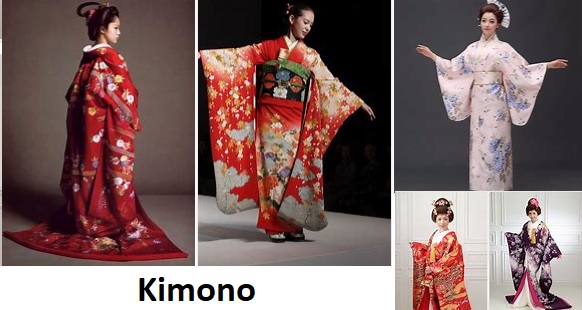Women's Kimono: Directory and Information Regarding Women's Kimono presented by Apparel Search
Women's Clothes Clothes Fashion Clothing Retail Stores Clothes Shopping Fashion News Fashion Designers Popular Brands Apparel Women's Clothing Stores Women's Clothing Wholesalers Women's Fashion
|
Are you actually looking for Women's Kimono? Well, we hope you are because the reality is that you have found our Women's Kimono page. |
The term means "garment"; ki means "to wear", and mono means "thing" or "object". It has come to mean full-length formal robes. The standard English plural is kimonos, but kimono is also used for the plural form in English as Japanese does not distinguish plural nouns. Kimonos are often worn for important festivals and formal occasions as formal clothing.
The kimono is a long, loose robe with wide sleeves and tied with a sash.
The general rule with a kimono or yukata is that younger people wear bright, vivid colors and bold patterns, while older people wear dark, matured colors and dull patterns. A child may wear a multicolored print and a young woman may wear a floral print, while an older woman would confine herself to a traditional dark blue with geometric patterns.
This garment was originally worn as a formal garment in Japan and now also used elsewhere as a robe.
Today, kimono are most often worn by women, particularly on special occasions. Traditionally, unmarried women wore a style of kimono called furisode, with almost floor-length sleeves, on special occasions.
In modern-day Japan the meanings of the layering of kimono and hiyoku are usually forgotten. Only maiko and geisha now use this layering technique for dances and subtle erotic suggestion, usually emphasizing the back of the neck. Modern Japanese brides may also wear a traditional Shinto bridal kimono which is worn with a hiyoku.
- A maiko (舞妓) (/ˈmaɪkoʊ/, Japanese: [ma.iko]) is an apprentice geisha in Kyoto and Western Japan. Their jobs consist of performing songs, dances, and playing the shamisen or other traditional Japanese instruments for visitors during ozashiki.
- Geisha (芸者) (/ˈɡeɪʃə/; Japanese: [ɡeːɕa]), geiko (芸子), or geigi (芸妓) are Japanese women who entertain through performing the ancient traditions of art, dance and singing, and are distinctively characterized by traditional costumes and makeup.
- Shinto (神道 Shintō) or kami-no-michi is the traditional religion of Japan that focuses on ritual practices to be carried out diligently to establish a connection between present-day Japan and its ancient past.
The Japanese yukata is an unlined, cotton kimono worn as a bathrobe or as summer outdoor clothing.
- A yukata (浴衣) is a Japanese garment, a casual summer kimono usually made of cotton or synthetic fabric, and unlined. Like other forms of traditional Japanese clothing, yukata are made with straight seams and wide sleeves.
- A standard yukata ensemble consists of a cotton undergarment (juban), yukata, obi, bare feet, sandals (geta), a foldable or fixed hand fan, and a carry bag (kinchaku). Kinchaku are used by both men and women to carry cellphones and other small personal items.
- The left side of the yukata is wrapped over the right side (commonly reversed with right over left when dressing a body for a funeral) and secured with an obi sash tied in a bow with the excess or with the koshi-himo. Traditionally the bow is placed in the back as historically bows tied in the front have represented prostitution. In private, such as after a bath, the yukata may be simply belted. Yukata are often worn with wooden sandals called geta, but tabi are not usually worn.
- Traditionally yukata were mostly made of indigo-dyed cotton but today a wide variety of colors and designs are available.
How to care for your kimono:
Like many other traditional Japanese garments, there are specific ways to fold kimono. These methods help to preserve the garment and to keep it from creasing when stored. Kimonos are often stored wrapped in paper called tatōshi. Kimono need to be aired out at least seasonally and before and after each time they are worn. Many people prefer to have their kimono dry cleaned. Although this can be extremely expensive, it is generally less expensive than arai hari but may be impossible for certain fabrics or dyes.
Traditional Japanese kimono have beautiful patterns and designs that can be intricate or simple, but are all unique.
Kimono textiles can to be classified into two categories: Gofuku(呉服), which indicates silk textiles in general, for luxuries and cotton/hemp Futomono(太物) for everyday wear.
Kimonos are traditionally made from a single bolt of fabric called a tan. Tan come in standard dimensions—about 36 centimetres wide and 11.5 metres long, and the entire bolt is used to make one kimono. The finished kimono consists of four main strips of fabric—two panels covering the body and two panels forming the sleeves—with additional smaller strips forming the narrow front panels and collar. Historically, kimonos were often taken apart for washing as separate panels and resewn by hand. Because the entire bolt remains in the finished garment without cutting, the kimono can be retailored easily to fit another person.
You may also have interest in Women's kimono robes or Women's kimono dresses. Apparel Search is a leading guide to fashion, style, clothing, glam and all things relevant to apparel. We hope that you find this Women's Kimono page to be helpful.
If you want to be even more stylish, you should wear your favorite women's kimono.
Apparel Search
Add Your Company
Contact Us
About Us
Advertise
News Letter
Legal
Help
Copyright © 1999-2023 Apparel Search Company.
All Rights Reserved.

